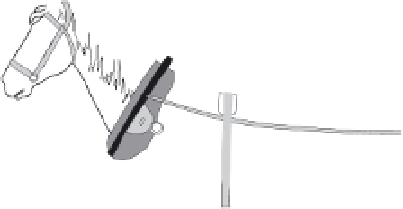Environmental Engineering Reference
In-Depth Information
always done best with horses, and proper harnessing was a
decisive factor in utilizing most efficiently their large draft
capabilities (des No¨ttes 1931; Haudricourt and Delam-
arre 1955; Needham 1965; Spruytte 1983). Mules,
hybrids of male donkeys and mares, were favored in the
southern United States because they could tolerate poor
feeding and grooming, even neglect and abuse, better
than horses (Kauffman 1993).
Throat-and-girth harness, documented in all ancient
horse-using cultures, was not suitable for heavy draft.
The breastband harness, a Chinese invention dating back
at least to the early Han dynasty, increased the efficiency
of draft, but the point of traction was too far back from
the most powerful shoulder and breast muscles. The de-
sign spread across Euroasia and reached Italy as early as
the fifth century, and northern Europe some 300 years
later. The origins of the collar harness are also in China,
perhaps in the first century
B
.
C
.
E
., as a soft support for the
hard yoke, later transformed into a single component.
The design reached Europe by the ninth century and
was universally adopted by the end of the twelfth cen-
tury. Usually made in one piece, with an oval wooden
(later also metal) frame, softly lined to fit a horse's
shoulders (often with a collar pad underneath) and with
attachments just above the animal's shoulder blades to
connect the draft traces, the collar harness offers the
most comfort and the most efficient way to pull heavy
loads (fig. 6.4).
Working bovines on all continents have been har-
nessed by neck or head yokes. The double neck yoke
was the most widespread type used in Africa, the Middle
East, and the Indian subcontinent. A beam, often shaped
to fit the neck, is held in place by wooden sticks, chains,
or ropes. Its throat fastenings tend to choke the animals,
its point of traction is high, the animals must be of the
6.4 Major components of the modern horse collar harness.
From Smil (1994).
same size, and a pair of animals must be used where one
would otherwise suffice. The single neck yoke was domi-
nant in East Asia as well as in Central Europe. The an-
cient Mesopotamian harness became common in Spain
and Latin America; this double head yoke was fixed ei-
ther at the front or the back of the head and was best
suited for strong, short-necked animals. A more comfort-
able single head yoke was used in parts of Europe.
No draft animal offers a universal fit. Horses, powerful,
fast, smart, and easy to handle, were often too light,
underperformed in the tropics, and were expensive to
harness. Oxen, slow and difficult to train, had the com-
pensating advantages of stolidity, simple harnessing, and
easy feeding. A working animal that best fits its environ-
ment is the water buffalo (Cockrill 1974). Male castrates
used for work, as heavy as good-size horses, look clumsy.
In reality, they are nimble and move easily on the steep,
narrow earth bunds that divide rice fields as well as in the
slippery, deep mud of the fields. Their large hoofs and






























